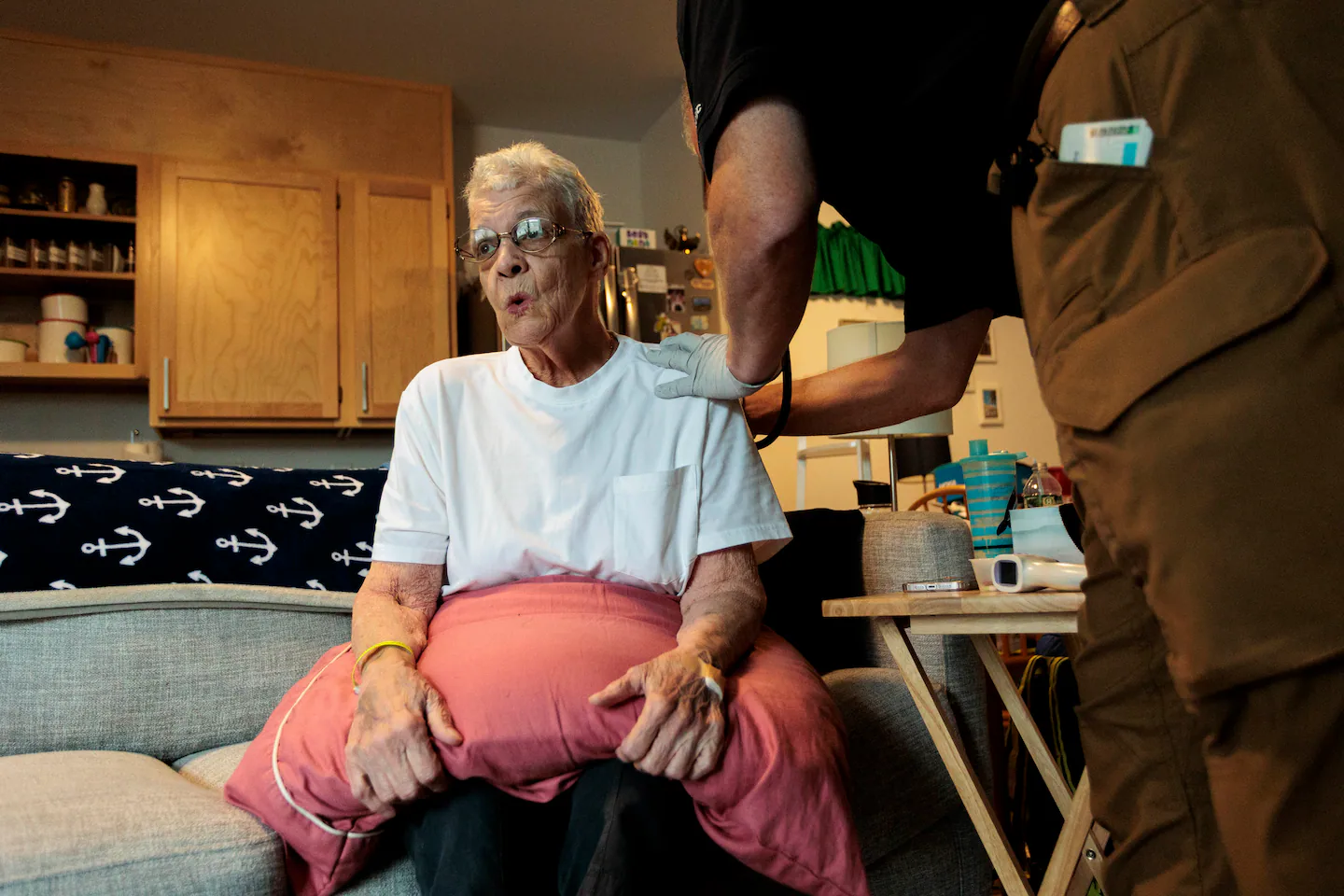
“It’s like a dream come true,” Ward said during her morning check-in with an MGB paramedic. “I won the lottery.”
Patients like Ward say they eat better, sleep better, feel better, and ultimately heal better in the comfort of their homes, but the federal program that allows them to do that could soon come to a standstill, a victim of the inertia on Capitol Hill. Despite bipartisan support, the Medicare provision that allows the program expires on Sept. 30, and it’s anyone’s guess whether Congress, embroiled in another potential government shutdown, will act to save it.
“It’s really worrisome that it would halt the momentum that we have seen growing around hospital-at-home,” said Adam Delmolino, senior director of virtual care and clinical affairs at the Massachusetts Health and Hospital Association. “It’s really critically important. We want this to be able to continue.”
Hospital beds remain in short supply, especially in New England, where Rhode Island and Massachusetts lead the nation in hospital bed occupancy. Home hospitals have served as a release valve.
Providing hospital services at patients’ homes became widespread during the COVID-19 pandemic, when the Centers for Medicare and Medicaid Services permitted the practice to open badly needed hospital beds. Patients who qualify are transported home by ambulance, set up with a portable monitoring system, and visited in-person at least twice daily by nurses or paramedics.
The results of the five-year experiment are promising. Hospital-at-home patients were discharged to skilled nursing facilities less than 1 percent of the time, compared to 11 percent for patients in traditional hospital settings, according to a recent report from the Massachusetts Health Policy Commission.
While at home, patients can move more. They are exposed to fewer hospital-acquired infections. They have more time to recover because no other patients are waiting for their beds.
Proponents of the model said the care given during a hospital-at-home stay is virtually the same as in a hospital building (and so are the costs.) The biggest difference: A nurse isn’t onsite with the patient at all hours of the day.
Charlie Carey, a paramedic who visited Ward recently, arrived in a truck outfitted as an ambulance, carrying all of the supplies he needed to draw blood, administer IV medications, and place urinary catheters. Carrying a large blue and green backpack, he brought Ward 24 hours’ worth of her medications.
Ward sat on her couch while Carey asked her about lingering symptoms she had before setting up a call with MGB physician assistant Aoife Fitzpatrick. Ward mentioned acid reflux, joking that she probably got it from eating eggplant parmesan from a local pizza place.
“Do you take anything for that?” Fitzpatrick asked.
“I do, but something I just got from BJs,” Ward said before turning toward her kitchen and pointing. “If you want, you can look in that middle cabinet.”
This is one of the benefits of home hospital care, said Dr. Constantinos “Taki” Michaelidis, medical director of Hospital at Home at UMass Memorial Health in Worcester. Providers can see into the home of their patients and glean details that might not be mentioned during a visit in a medical-surgical unit. For example, they may come across expired prescriptions that patients are still taking.
“We find a lot in the home that our brick-and-mortar counterparts just don’t have access to seeing,” Michaelidis said. “It’s not because they’re not amazing doctors, nurses, or medics — they are — but they’re just not in the home.”
Some patients are frequent users of the hospital-at-home programs. Kim Dumais-Hutt, for instance, was in and out of the hospital constantly over the last few years because of liver and bile-duct problems. The first time she was offered hospital-at-home care at Mass Memorial, she was nervous — what if something went wrong?
But within minutes of being back at her home in Worcester, the former preschool teacher knew it was the right decision. She had her cats, she could have visitors any time she wanted, and she could get up to go to the bathroom without assistance.
When she landed in the hospital again a few months later, she jumped at the chance to get care from the comfort of her living room.
“I don’t even think they finished their sentence,” Dumais-Hutt said. “I was like, ‘Oh my God, please get me out.’ ”
Hospitals and community leaders are fighting to keep the hospital-at-home option alive. Lawmakers from both parties, including Senator Sheldon Whitehouse, Democrat of Rhode Island, have cosponsored bills that would extend the program for five years. It’s not clear whether those bills will be considered before Sept. 30.
Hospital officials hope that extending the program will be included in whatever short-term funding bill Congress might pass to keep the government open, and ultimately Congress will renew the program for another five years. But they worry that disruptions caused by a government shutdown or delays in renewing the program for the long term would discourage health systems from continuing or adopting hospital-at-home care.
“We need to find ways to deliver care to meet the rising demand, and we can’t keep doing it the way we’ve consistently done it for the last 50 years,” said Dr. Stephen Dorner, chief of clinical operations and medical affairs at MGB Healthcare at Home. “Our firm belief, and what we continue to advocate for, is not these short-term extensions, but really a long runway that will give the stability that’s necessary.”



